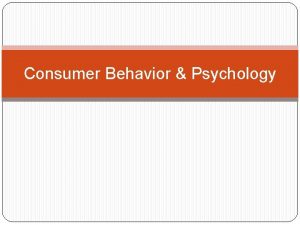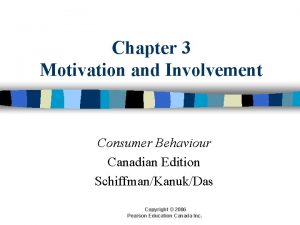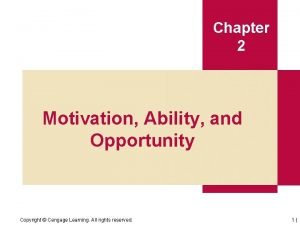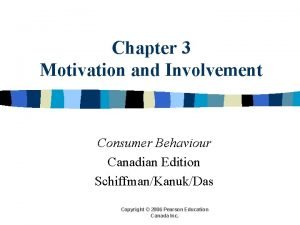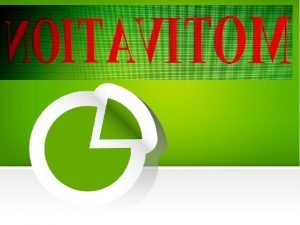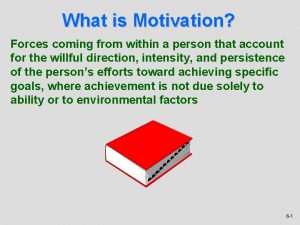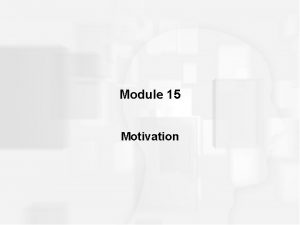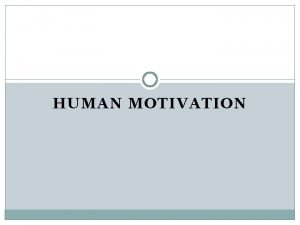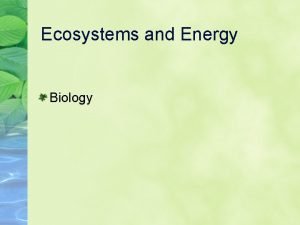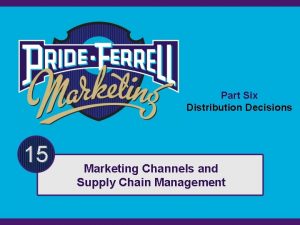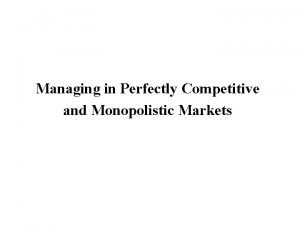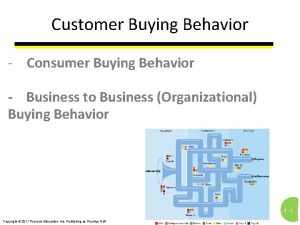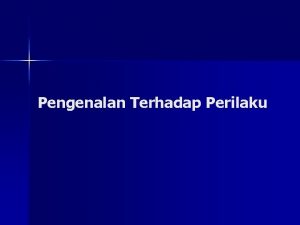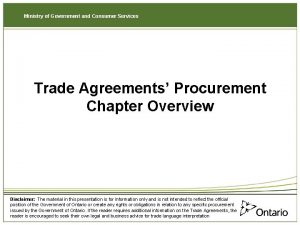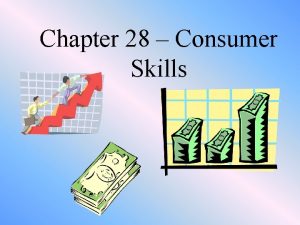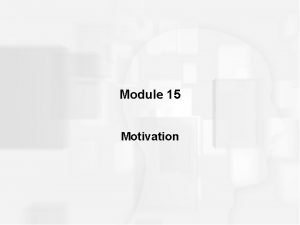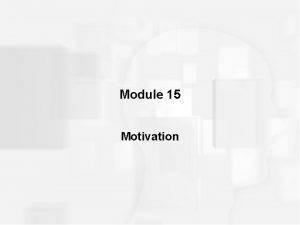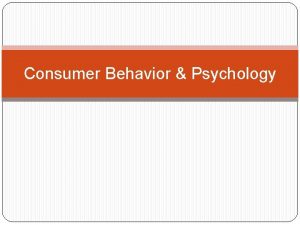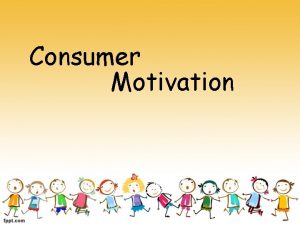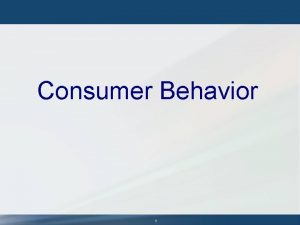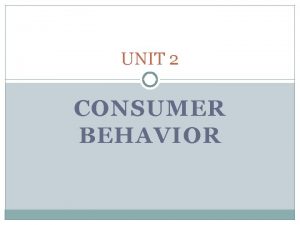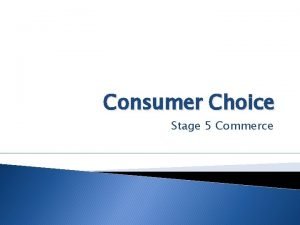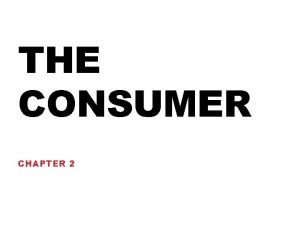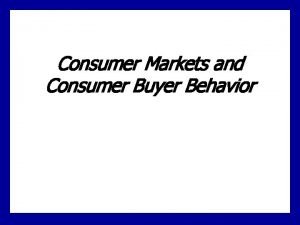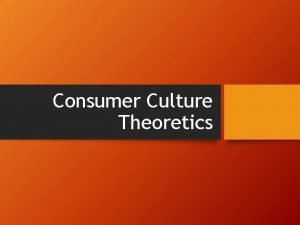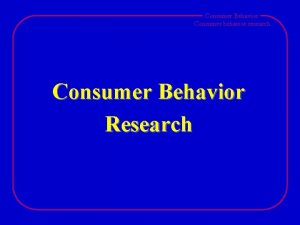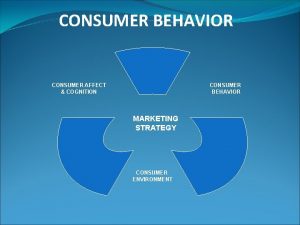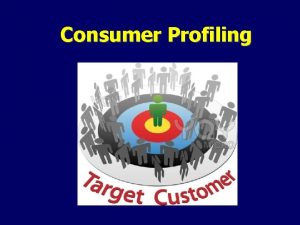CONSUMER MOTIVATION What is Motivation Motivation refers to























- Slides: 23

CONSUMER MOTIVATION

What is Motivation? Motivation refers to an activated state within a person that leads to goal-directed behavior. It consists of the drives, urges, wishes, or desires that initiate the sequence of events leading to a behavior.

Motivation begins with the presence of a stimulus (psychology) that spurs the recognition of a need. Need recognition occurs when a perceived discrepancy exists between an actual and a desired state of being Needs can be either innate or learned. Needs are never fully satisfied. Feelings and emotions (I. e. , affect) accompany needs e. g. opposite gender ads shall stand more attractive as they have more emotional interaction Expressive needs involve desires by consumers to fulfill social and/or aesthetic requirements e. g. even fear can induce people to buy mineral water. Utilitarian(in the interest of utility) needs involve desires by consumers to solve basic problems (e. g. filling a car’s gas tank).

The Structure of Emotions Ten Fundamental Emotions People Experience: Disgust Interest Joy Surprise Sadness Anger Fear Contempt Shame Guilt

Some General Theories of Motivation Maslow hierarchy: physical, safety, belongingness, ego, and self-actualiation Mc. Clelland’s Theory of Learned Needs Achievement motivation is seeking to get ahead, to strive for success, and to take responsibility for solving problems e. g. a person may have a need to arouse the hot water with the help of a Geyser. Need for affiliation motivates people to make friends, to become members of groups, and to associate with others e. g. a sports lover may buy Sachin Tendulkar endorsed products. Need for power refers to the desire to obtain and exercise control over others e. g. on holidays we call “home away from home“. Need for uniqueness refers to desires to perceive ourselves as original and different COCA COLA & the BRANDS of the world.

Classical Conditioning A neutral stimulus, such as a brand name, is paired with a stimulus that elicits a response. Through a repetition of the pairing, the neutral stimulus takes on the ability to elicit the response.

The conditioned stimulus (CS) is a previously neutral stimulus which is repeatedly paired with the eliciting stimulus. The unconditioned stimulus (UCS) is an eliciting stimulus. The conditioned response (CR) is the response elicited by the CS. The unconditioned response (UCR) is the reflexive response elicited by the unconditioned stimulus.

Classical Conditioning Relations Unconditioned/Secondary Stimulus Unconditioned Response Flag Emotions Pairing Political candidate Conditioned Stimulus Emotions Conditioned Response

Requirements for Effective Conditioning The neutral stimulus should precede in time the appearance of the unconditioned stimulus. The product is paired consistently with the unconditioned stimulus. Both the conditioned stimulus and the unconditioned stimulus are highly salient to the consumer.

Applications of Classical Conditioning Applications: communications--advertising, public relations, personal selling. Goal: identify powerful positive stimulus and associate brand with it. Examples of powerful, emotion causing stimuli: beautiful, young, sporty people patriotic themes, religious symbols Music, beautiful scenes Also, negative stimuli can be associated with competitors. Credit card insignia (membership) may elicit spending responses

Choosing the telecommunication companies, in general, there is a prevalent appliance of Classical conditioning. Currently, classical conditioning is being applied by companies through the association of particularly catchy jingles and appearance of picky models with their particular services. Through extensive promotion of these jingles, companies attempt to develop an involuntary recognition of their products within the target market. Taking Telenor as an example, it has developed an unintentional relevance of these jingles and models with their brand, in the target market. So now even by hearing the promo sound of their respective jingle, the first thing com to customer’s mind is Telenor.

This recognition by the masses has not only built a strong customer interface, but has also motivated the customer for subsequent purchases, through persuasive marketing. Also the existing customers have developed a strong brand loyalty and attach certain values to the brand. This is a very positive effect of the classical conditioning, giving the brand a competitive edge. Over all, in order to improve sales and brand image, the company should skillfully divide the target market into different segments so as to give particular importance to the respective segments. For example a large part of the target market of Telenor is youth and young

in their 20 s, so new packages and services should be devised keeping in view their particular characteristics and priorities. In addition, market can also be divided into segments based on different classes of customers; that is, economy packages, and business packages and so on. Classical conditioning theory can then be applied to these new segments more effectively, therefore taking Telenor to the heights of success. Also the management should concentrate on customer satisfaction, as the service industry is more or less based on word of mouth and the extent of satisfaction the customer achieves.

Operant Conditioning. . . is the process in which the frequency of occurrence of a bit of behavior is modified by the consequences of the behavior. If positively reinforced, the likelihood of the behavior being repeated increases. If punished, the likelihood of the behavior being repeated decreases. Competing with Coca Cola based on taste, Pepsi's "Forever Young" commercials are an example of how Pepsi is trying to pair drinking Pepsi with feeling young again

Reinforcement & Influencing Behavior A reinforcer is anything that occurs after a behavior and changes the likelihood that it will be emitted again. Positive reinforcers are positive rewards that follow immediately after a behavior occurs. Negative reinforcers are the removal of an aversive(avoiding) stimulus. E. g. For example, sometimes when you purchase a product, the company offers a rebate on that particular product. That includes receiving money back when the receipt of the purchased product is sent to the company. When you purchase the specific product you are being reinforced to make the actual purchase because of the reward of receiving money back. There are two types of reinforcements, positive and negative. Positive reinforcers bring pleasant consequence abrupt by adding something pleasant to the environment. . .

A Punisher. . . is any stimulus whose presence after a behavior decreases the likelihood of the behavior reoccurring.

Discriminative Stimuli. . . are those stimuli (sensory receptor) that occur in the presence of a reinforcer and do not occur in its absence. Example: point of purchase display is a discriminative stimulus i. e. quality, price, atmosphere, ambiance, price, social marketing, applying m. mix

Vicarious/ Social Modelling Learning. . . is the phenomenon where people observe the actions of others to develop “patterns of behavior. ”

Three important ideas: People are viewed as symbolic beings who foresee the probable consequences of their behavior. People learn by watching the actions of others and the consequences of these actions (i. e. vicarious learning). People have the ability to regulate their own behavior.

7 Types of Consumer Risks. Financial Performance Physical Psychological Social Time Opportunity Loss

Factors Influencing Risk Perception Characteristics of the person—e. g. , need for stimulation Nature of the task Characteristics of the product—price Salience of negative outcomes

Six risk-reduction strategies Be brand loyal and consistently purchase the same brand. Buy through brand image and purchase a quality national brand. Buy through store image from a retailer that you trust. Seek out information in order to make a well informed decision. Buy the most expensive brand, which is likely to have high quality. Buy the least expensive brand in order to reduce financial risk.

Managerial Applications of Motivation Positioning/differentiation: use discriminative stimuli distinguish one brand from another. Environmental analysis: identify the reinforcers and punishers that impact consumers; identify factors that influence risk perception. Market research: measure motivational needs (e. g. , Mc. Clelland’s needs and need for arousal), measure risk perception. Marketing mix: use motivational needs to design products (e. g. , safe cars) and to develop promotional strategy that meets needs. Develop messages to influence consumer attributions. Use in-store promotions to prime consumers. Segmentation: Segment market based upon motivational needs.
 Secondary consumer in the food chain
Secondary consumer in the food chain Consumer markets and consumer buyer behavior
Consumer markets and consumer buyer behavior Consumer diversity in consumer behaviour
Consumer diversity in consumer behaviour Consumer research in consumer behaviour
Consumer research in consumer behaviour Chapter 5 consumer markets and buyer behavior
Chapter 5 consumer markets and buyer behavior Primary consumer
Primary consumer Consumer behavior refers to
Consumer behavior refers to Dynamic nature of motivation in consumer behaviour
Dynamic nature of motivation in consumer behaviour Motivation, ability, and opportunity consumer behaviour
Motivation, ability, and opportunity consumer behaviour Examples of generic goals and product-specific goals
Examples of generic goals and product-specific goals Dynamics of motivation in consumer behaviour
Dynamics of motivation in consumer behaviour Evolutionary theory of motivation
Evolutionary theory of motivation Hierarchy of c's
Hierarchy of c's Motivation refers to
Motivation refers to Motivation refers to
Motivation refers to Consumer choices definition
Consumer choices definition Primary producers
Primary producers Single channel distribution
Single channel distribution Tr
Tr Buying centre roles
Buying centre roles Tingkah laku overt
Tingkah laku overt Ministry of government and consumer services
Ministry of government and consumer services Consumer skills
Consumer skills Neo freudian theory in consumer behaviour
Neo freudian theory in consumer behaviour






